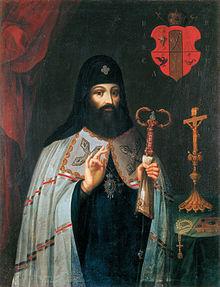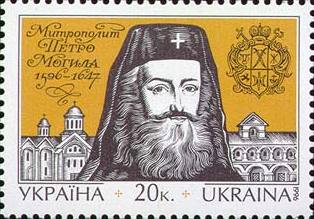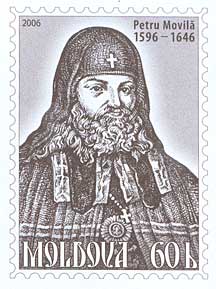
The history of Christianity in Ukraine dates back to the earliest centuries of the history of Christianity, to the Apostolic Age, with mission trips along the Black Sea and a legend of Saint Andrew even ascending the hills of Kyiv. The first Christian community on territory of modern Ukraine is documented as early as the 9th century with establishment of the Metropolitanate of Gothia centered in Crimean peninsula. However, on territory of the Old Rus in Kyiv it became the dominant religion since its official acceptance in 988 by Vladimir the Great, who brought it from Byzantine Crimea and installed it as the state religion of medieval Kyivan Rus (Ruthenia), with the metropolitan see in Kyiv.
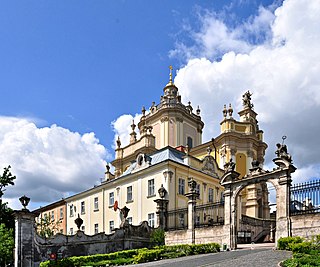
The Ukrainian Greek Catholic Church is a sui iuris Byzantine Rite Eastern Catholic church in full communion with the worldwide Catholic Church. It is the second-largest particular church in the Catholic Church, second only to the Latin Church. It is part of the Major Archiepiscopal Churches of the Catholic Church that are not distinguished with a patriarchal title.

Saint Sophia Cathedral in Kyiv, Ukraine, is an architectural monument of Kyivan Rus. The cathedral is one of the city's best known landmarks and the first heritage site in Ukraine to be inscribed on the World Heritage List along with the Kyiv Cave Monastery complex. Aside from its main building, the cathedral includes an ensemble of supporting structures such as a bell tower and the House of Metropolitan. In 2011 the historic site was reassigned from the jurisdiction of the Ministry of Regional Development of Ukraine to the Ministry of Culture of Ukraine. One of the reasons for the move was that both Saint Sophia Cathedral and Kyiv Pechersk Lavra are recognized by the UNESCO World Heritage Program as one complex, while in Ukraine the two were governed by different government entities.

Meletius Smotrytsky, né Maksym Herasymovych Smotrytsky, Archbishop of Polotsk, was a writer, a religious and pedagogical activist of the Polish–Lithuanian Commonwealth, a Ruthenian linguist whose works influenced the development of the Eastern Slavic languages. His book "Slavonic Grammar with Correct Syntax" (1619) systematized the study of Church Slavonic and, according to Vinokur, "became the standard grammar book in Russia right up till the end of the 18th century." He believed in the revival of the Orthodox religion in traditionally Slavic lands centered in the Tsardom of Russia.

Petro Konashevych-Sahaidachny was a Ukrainian political and civic leader, Hetman of Ukrainian Zaporozhian Cossacks from 1616 to 1622, a military leader of Polish–Lithuanian Commonwealth both on land and sea. While being a Cossack Hetman, he transformed the Cossack Host from the erratic military formation into regular army. Under his leadership the cossacks, the Orthodox clergy and peasants had been begun to emerge as the united nation. His troops played a significant role in the Battle of Khotyn against the Turks in 1621 and prince Władysław's attempt to gain the Muscovy throne in 1618.
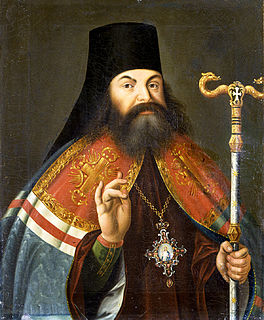
Feofan/Theophan Prokopovich was a Russian Imperial Orthodox theologian, writer, poet, mathematician, and philosopher of Ukrainian origin. Rector of the Academia Mohileana in Kiev, and Archbishop of Novgorod. He elaborated upon and implemented Peter the Great's reform of the Russian Orthodox Church. Prokopovich wrote many religious verses and some of the most enduring sermons in the Russian language.

National University of Kyiv-Mohyla Academy (NaUKMA) is a national, research university located in Kyiv, Ukraine. The Kyiv-Mohyla Academy, the school's predecessor, was established in 1615. The NaUKMA is located on the Academy's grounds in the ancient Podil neighborhood. In 1991, it was re-organized, and teaching began the following year. NaUKMA has the highest level of accreditation as outlined by the Ministry of Education and Science of Ukraine, and is one of the thirteen educational institutions in Ukraine having a status of a research and autonomous university. NaUKMA takes part in numerous international university collaborations, such as the European University Association. The university is bilingual in Ukrainian and English. It is one of Ukraine's few universities with internationally recognized diplomas.

Michael the Brave was the Prince of Wallachia, Prince of Moldavia (1600) and de facto ruler of Transylvania. He is considered one of Romania's greatest national heroes. Since the 19th century, Michael the Brave has been regarded by Romanian nationalists as a symbol of Romanian unity, as his reign marked the first time all principalities inhabited by Romanians were under the same ruler.

Ieremia Movilă, was a Voivode (Prince) of Moldavia between August 1595 and May 1600, and again between September 1600 and July 10, 1606.

Holy Dormition Pochayiv Lavra is a monastery in Pochayiv, Kremenets Raion, Ternopil Oblast, Ukraine. The monastery belongs to the Ukrainian Orthodox Church. For centuries, it has been the foremost spiritual and ideological centre of various Orthodox denominations in Western Ukraine. The monastery tops a 60-metre hill in the town of Pochayiv, 18 km southwest of Kremenets and 70 km north of Ternopil.
The Early Modern Times in Romania started after the death of Michael the Brave, who ruled in a personal union, Wallachia, Transylvania, and Moldavia – three principalities in the lands that now form Romania – for three months, in 1600. The three principalities were subjected to the Ottoman Empire, and paid a yearly tribute to the Ottoman Sultans, but they preserved their internal autonomy. In contrast, Dobruja and the Banat were fully incorporated into the Ottoman Empire.

The Movileşti, also Movilă family or Moghilă family, were a family of boyars in the principality of Moldavia, which became related through marriage with the Muşatin family – the traditional House of Moldavian sovereigns.

Simion Movilă, a boyar of the Movileşti family, was twice Prince of Wallachia and Prince of Moldavia from July 1606 until his death.

The Khotyn Fortress is a fortification complex located on the right bank of the Dniester River in Khotyn, Chernivtsi Oblast (province) of western Ukraine. It is situated on a territory of the historical northern Bessarabia region which was split in 1940 between Ukraine and Moldova. The fortress is also located in a close proximity to another famous defensive structure, the Old Kam'yanets Castle of Kamianets-Podilskyi. Construction on the current Khotyn fortress was started in 1325, while major improvements were made in the 1380s and in the 1460s.

The Kiev Theological Academy (1819—1919) was one of the oldest higher educational institution of the Russian Orthodox Church, situated in Kiev, the Russian Empire. It was considered as the most senior one among similar academies in Moscow, Saint Petersburg, and Kazan. It was located at the Kiev Podol within the Kiev Epiphany Monastery. In the Russian historiography, the Academy′s predecessor was the Academia Kiioviensis Mohileana that was founded earlier in the 17th century.

The Dormition or Assumption Church is a Ukrainian Orthodox church in the city of Lviv, Ukraine. At present it is leased to the Ukrainian Autocephalous Orthodox Church.

Sylvester Kossów, Kosiv or Kosov was a Ruthenian Orthodox metropolitan of the Polish–Lithuanian Commonwealth and Polish-Ruthenian writer. He served as metropolitan of Kiev, Galicia and all Ruthenia (1647–1657) during the Khmelnytsky uprising. His official title was Metropolitan of Kiev, Galicia and All-Ruthenia.
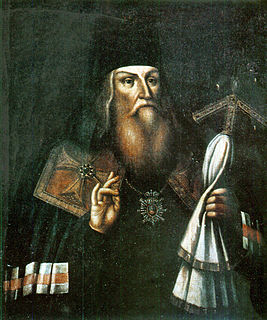
Lazar Baranovych or Baranovich was a Ruthenian Eastern Orthodox archbishop of the Polish–Lithuanian Commonwealth and then of the Tsardom of Russia. Ecclesiastical, political, and literary figure, professor (1650) and rector of the Kievan Mohyla College, bishop and archbishop of Chernihiv from 1657. He founded schools and monasteries. In 1674 he established a printing house at the Monastery of Holy Transfiguration in Novhorod-Severskyi, which in 1679 was moved to Chernihiv.

Brotherhoods were the unions of Eastern Orthodox citizens or lay brothers affiliated with individual churches in the cities throughout the Ruthenian part of the Polish–Lithuanian Commonwealth such as Lviv, Wilno, Lutsk, Vitebsk, Minsk, and Kyiv. Their structure resembled that of Western medieval confraternities and trade guilds.
The chronology of Ukrainian language suppression and Russification of Ukraine.
